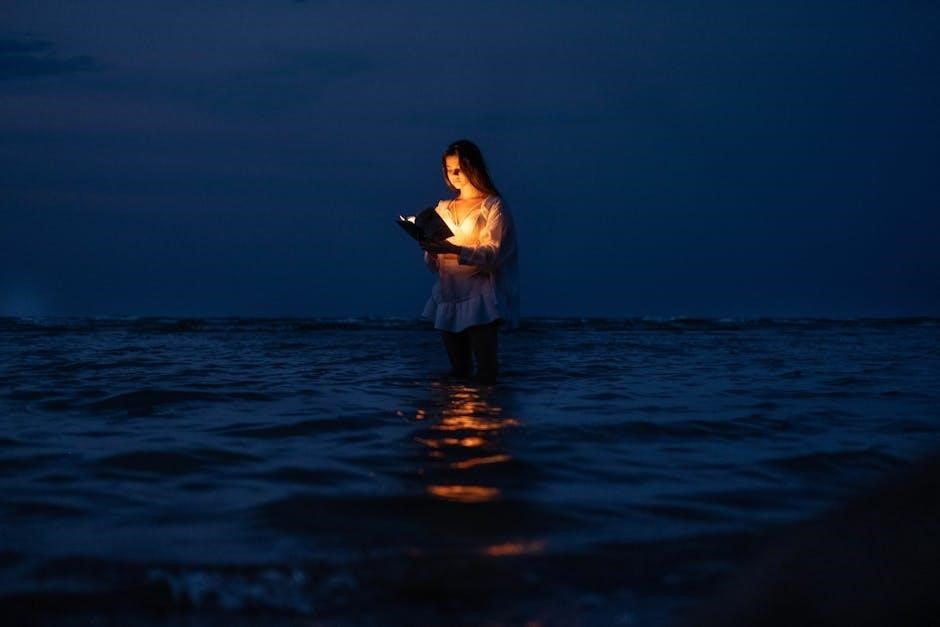Laura Esquivel’s Like Water for Chocolate is a beloved novel combining romance, family traditions, and magical realism. The PDF version is available for free download online.
Overview of the Novel
Like Water for Chocolate, written by Laura Esquivel, is a captivating blend of romance, magical realism, and family traditions. The story revolves around Tita, the youngest daughter of Mama Elena, who is destined to care for her mother due to a family curse. Tita’s life is marked by forbidden love for Pedro, who marries her sister Rosaura to remain close to her. The novel is divided into monthly installments, each featuring recipes, home remedies, and emotional depth. Set in early 20th-century Mexico, it explores themes of love, loss, and cultural heritage. The book’s magical realism infuses ordinary events with extraordinary elements, creating a unique reading experience. Available in PDF and digital formats, it remains a beloved classic, translated into over 30 languages, continuing to enchant readers worldwide with its rich storytelling and emotional resonance.
Author Laura Esquivel
Laura Esquivel is a renowned Mexican novelist, screenwriter, and politician, best known for her debut novel Like Water for Chocolate. Born in Mexico City, Esquivel began her career as a teacher and later transitioned to writing, blending magical realism with vivid storytelling. Her unique style captured global attention, making her a pivotal figure in contemporary Mexican literature. Like Water for Chocolate, published in 1989, became an international bestseller, translated into over 30 languages. Esquivel also wrote the screenplay for the novel’s film adaptation, further cementing its legacy. Her work is celebrated for its emotional depth and cultural resonance, and the book remains widely available in PDF and other digital formats, ensuring its accessibility to readers worldwide.
Historical Context of the Book
Like Water for Chocolate is set against the backdrop of the Mexican Revolution, a time of profound political and social upheaval. The novel follows the De la Garza family as they navigate the challenges of war, family traditions, and personal struggles. The Revolution serves as more than just a setting; it actively shapes the characters’ lives and relationships. Tita, the protagonist, experiences the direct impact of the war on her family and her own destiny. Laura Esquivel skillfully weaves historical events into the narrative, using them to explore themes of love, resilience, and cultural identity. The historical context enriches the story, providing depth to the characters’ journeys and the enduring magic of the novel.

The Plot and Structure
Like Water for Chocolate follows Tita De la Garza as she navigates a forbidden love, family traditions, and magical cooking, blending romance, drama, and whimsical elements seamlessly.
Setting: Time and Place
Like Water for Chocolate is set during the Mexican Revolution, a time of political upheaval and social change. The story takes place on a remote ranch, El Patio de las Flores, near the U.S.-Mexico border. This isolated location emphasizes the De la Garza family’s deep-rooted traditions and their disconnection from the outside world. The ranch serves as a central hub for the narrative, with its kitchen playing a symbolic role in Tita’s life. The temporal and spatial settings create a backdrop of both intimacy and confinement, allowing the blend of realism and magical elements to thrive. The Revolution’s backdrop subtly influences the characters’ lives, adding layers of tension and transformation.
Main Characters and Their Roles
- Tita De la Garza: The protagonist, Tita is the youngest daughter of Mama Elena, destined to care for her mother and forbidden to marry. Her emotions infuse her cooking, making it extraordinary.
- Mama Elena: Tita’s strict, controlling mother who enforces family traditions and opposes Tita’s love for Pedro. Her harshness stems from her own bitter past.
- Pedro Muzquiz: Tita’s lifelong love, who marries her sister Rosaura to remain close to her. His devotion to Tita endures despite societal expectations.
- Rosaura De la Garza: Tita’s older sister, who marries Pedro and represents the oppressive traditions that Tita rebels against.
- Dr. John Brown: A kind doctor who supports Tita emotionally and helps her find independence and love later in life.
- Nacha: The loyal housekeeper who teaches Tita the art of cooking and becomes a surrogate mother figure.

These characters’ complex relationships and struggles drive the emotional depth of the story, exploring themes of love, family, and identity.
Key Events and Turning Points
- Tita’s forbidden love for Pedro Muzquiz ignites the central conflict, as tradition forbids her from marrying due to her role as the youngest daughter.
- Pedro marries Tita’s sister Rosaura to stay close to Tita, creating a tense family dynamic and unrelenting emotional turmoil.
- The death of Mama Elena liberates Tita but also unleashes a flood of repressed emotions and memories tied to her oppressive upbringing.
- The arrival of Dr. John Brown brings hope and emotional support to Tita, offering her a chance for love and independence.
- The destruction of the ranch by fire symbolizes the end of an era and Tita’s final break from her oppressive past.
- Tita’s creation of the family cookbook becomes a testament to her resilience and the enduring power of love and tradition.
These events shape Tita’s journey, highlighting her struggle for love, freedom, and self-discovery in a world bound by tradition.

Themes and Symbolism
The novel explores themes of love, tradition, and female empowerment, blending magical realism. Food and cooking symbolize emotional expression and cultural heritage, highlighting the protagonist’s journey.
Love and Family Traditions
The novel delves into the intricate interplay between love and family traditions, particularly through Tita’s journey. As the youngest daughter, Tita is bound by tradition to care for her mother, Mama Elena, and sacrifice her own desires. The forbidden love between Tita and Pedro drives the narrative, showcasing the tension between personal passion and familial obligations. Family traditions, such as the preparation of the wedding and the cultural significance of the ranch, are central to the story. These customs, while deeply rooted in heritage, often suppress individuality, especially for women. The kitchen becomes a space where Tita expresses her emotions, blending love, food, and tradition. This duality highlights the strength and suffocation that family traditions can bring, making Tita’s struggle both poignant and relatable.
Magical Realism in the Novel
Like Water for Chocolate is a quintessential example of magical realism, blending the ordinary with the extraordinary. Laura Esquivel masterfully weaves magical elements into the narrative, creating a captivating and dreamlike atmosphere. Tita, the protagonist, possesses an extraordinary connection to food, where her emotions infuse her cooking, impacting those who consume it. For instance, her sorrowful tears in a wedding cake cause the guests to weep uncontrollably. Similarly, the character of Pedro embodies a supernatural intensity in his love for Tita, transcending normal human passion. The novel’s setting during the Mexican Revolution provides a realistic backdrop, enhancing the contrast with magical events. This genre allows Esquivel to explore profound themes like love, family, and identity, making the fantastical feel natural and integral to the story. Magical realism enriches the narrative, inviting readers into a world where the impossible coexists with the mundane, creating a unique and enchanting reading experience.
Cultural and Social Themes
Like Water for Chocolate delves deeply into rich cultural and social themes, reflecting the traditions and struggles of Mexican society during the early 20th century. The novel highlights the importance of family and the role of women, particularly in a patriarchal society where their voices are often suppressed. Tita’s struggles against her mother’s oppressive expectations and her longing for independence resonate with feminist themes. The story also explores societal hierarchies, emphasizing the divide between the wealthy and the working class. Additionally, the Mexican Revolution serves as a backdrop, illustrating the broader societal turmoil and its impact on individual lives. Through these themes, Laura Esquivel critiques traditional gender roles and societal norms, offering a powerful commentary on the cultural fabric of her native Mexico.

Adaptations and Interpretations
Like Water for Chocolate has been adapted into a successful film, TV series, and stage productions, each capturing the story’s magical and emotional essence, resonating with diverse audiences worldwide.
The 1992 Film Adaptation
The 1992 film adaptation of Like Water for Chocolate, directed by Alfonso Arau, brought Laura Esquivel’s magical realism to life on the big screen. The movie stayed faithful to the novel’s essence, capturing the intricate blend of romance, family traditions, and supernatural elements. Marco Leonardi and Lumi Cavazos starred as the doomed lovers, Pedro and Tita, delivering performances that resonated with audiences. The film’s success lay in its visually stunning portrayal of the story, with vibrant colors and emotional depth. It became a critical and commercial hit, earning several awards and further cementing the novel’s global popularity. The adaptation not only honored Esquivel’s vision but also introduced the story to a new audience, solidifying its place in cinematic history.
TV Series Adaptation (2023)
In 2023, Netflix and TelevisaUnivision released a highly anticipated TV series adaptation of Like Water for Chocolate, directed by Ana Celia Urquidi and Rita Guerrero. This series offered a fresh take on Laura Esquivel’s beloved novel, expanding on the story’s emotional depth and magical elements. The show featured a talented ensemble cast, including Nicole Acevedo as Tita and Eugenio Siller as Pedro, bringing new life to the iconic characters. The series explored themes of love, family, and tradition with vivid storytelling and stunning visuals. It also delved deeper into secondary characters and subplots, providing fans with a richer narrative experience. The 2023 adaptation was well-received for its faithfulness to the source material while introducing the story to a younger generation of viewers. Its release marked a new chapter in the enduring legacy of Esquivel’s work.
Stage and Other Adaptations
Like Water for Chocolate has also been adapted into various stage productions, further showcasing its universal appeal. A notable stage adaptation premiered in Mexico City in 1990, featuring a blend of theater, music, and dance to bring the story to life. The production emphasized the novel’s magical realism and emotional depth, resonating deeply with audiences. Additionally, the book has inspired numerous other creative interpretations, including radio dramatizations and even an opera. These adaptations highlight the versatility of Esquivel’s narrative, allowing it to transcend traditional storytelling mediums. Each interpretation has offered a unique perspective on the themes of love, family, and tradition, ensuring the story remains fresh and engaging for diverse audiences.

Publishing and Availability
Published by Editorial Planeta in 1989, Like Water for Chocolate is available in hardcover, paperback, and digital formats globally, ensuring widespread accessibility to readers.
Translations and Editions
Like Water for Chocolate has been translated into over 40 languages, making it a global literary phenomenon. The English translation by Thomas Christensen and Carol Christensen helped broaden its international appeal. Various editions, including paperback, hardcover, and special anniversary editions, have been released. The book is also available in digital formats, such as PDF, for easy access. Its widespread translations have allowed readers worldwide to connect with its magical realism and emotional depth. The novel’s accessibility in multiple languages and formats has contributed to its enduring popularity and cultural impact, ensuring its themes resonate across diverse audiences.
PDF Versions and Digital Formats
The digital versions of Like Water for Chocolate have made the novel more accessible to modern readers. The book is widely available in PDF format, allowing readers to access it on e-readers, tablets, and smartphones. Major platforms like Amazon Kindle, Google Books, and Apple Books offer the novel in digital formats. These versions often include features like adjustable fonts, bookmarks, and search functions, enhancing the reading experience. Additionally, many libraries provide digital lending options for the book. The PDF version is particularly popular for its convenience and portability, ensuring that the story reaches a broader audience. Digital formats have played a significant role in preserving the novel’s accessibility and relevance in the modern era.
Copyright and Legal Considerations
Like Water for Chocolate is protected under international copyright laws, with rights held by Laura Esquivel and her publisher, Doubleday. Sharing or downloading unauthorized PDF versions of the book violates these laws and can result in legal consequences. Publishers and authors rely on legitimate sales to sustain their work, making it important to support the book through official channels. While digital formats are convenient, ensuring that they are obtained legally is crucial to respecting intellectual property rights. Many official PDF versions are available for purchase through reputable online retailers, offering a lawful way to enjoy the novel. Adhering to copyright guidelines not only supports the author but also upholds the integrity of literary works globally.

Reception and Legacy
Like Water for Chocolate became a beloved classic, praised for its magical realism and emotional depth. It significantly influenced Mexican literature and remains a cultural phenomenon.
Critical Reviews and Acclaim
Like Water for Chocolate received widespread critical acclaim for its unique blend of magical realism, emotional depth, and rich storytelling. Critics praised Laura Esquivel’s ability to weave together vibrant characters, cultural traditions, and fantastical elements, creating a captivating narrative. The novel was particularly celebrated for its exploration of love, family, and identity, resonating with readers worldwide. Many reviewers highlighted the strong female protagonist, Tita, as a symbol of resilience and passion. The book’s success led to numerous awards and recognition, solidifying its place in contemporary literature. Its global popularity further cemented its status as a modern classic, with critics noting its timeless appeal and universal themes.
Impact on Mexican Literature
Like Water for Chocolate had a profound impact on Mexican literature, revitalizing interest in the genre of magical realism and showcasing the richness of Mexican culture. The novel’s success brought international attention to Mexican authors, inspiring a new generation of writers to explore their cultural heritage. Esquivel’s unique storytelling style, blending tradition with fantasy, influenced the direction of contemporary Mexican literature. The book also sparked a global appreciation for Mexican folklore, cuisine, and history, making it a cornerstone of cultural identity. Its influence extends beyond literature, as it has inspired adaptations and discussions about gender roles, family traditions, and national identity. The novel’s enduring popularity has solidified its place as a defining work in Mexican literary history, continuing to inspire both writers and readers worldwide.
Popular Cultural Influence
Like Water for Chocolate has left an indelible mark on popular culture, transcending literature to influence film, music, and even culinary traditions. The novel’s magical realism and emotional depth have inspired countless adaptations, including the 1992 film, which introduced the story to a global audience. Its themes of love, family, and identity resonate universally, making it a cultural phenomenon. The book’s fusion of food, romance, and magic has sparked trends in cooking shows and romantic literature. Additionally, its exploration of strong female characters has influenced feminist narratives in media. The novel’s iconic status has led to references in music, art, and even merchandise, cementing its place in global pop culture. Its enduring appeal continues to inspire new generations, ensuring its relevance in modern cultural discourse.

Analysis and Insights
Like Water for Chocolate masterfully blends magical realism with emotional depth, offering insights into love, tradition, and identity. Its rich narrative and vivid characters provide profound commentary on human experiences, making it a timeless exploration of culture and emotion.
Symbolism of Food and Cooking
Food and cooking in Like Water for Chocolate are deeply symbolic, reflecting emotions, traditions, and the protagonist Tita’s inner world. Each recipe serves as a medium for Tita to express her feelings, often magically impacting those who consume her dishes. The kitchen becomes a space of empowerment and connection to her heritage. Specific dishes, like the rose petal quail and the wedding cake, symbolize love, longing, and cultural rituals. Food bridges the gap between the spiritual and the mundane, highlighting the emotional and transformative power of cooking. This culinary symbolism enriches the narrative, making it a vivid exploration of tradition, identity, and the universal language of food.
Feminist Perspectives

Like Water for Chocolate offers a powerful exploration of feminist themes, particularly through Tita’s journey of self-discovery and defiance against patriarchal norms. The novel portrays Tita’s struggle for independence in a society dominated by rigid gender roles and family expectations. Her mother, Mama Elena, embodies the oppressive traditions that Tita rebels against, symbolizing the tension between conformity and individuality. The kitchen, Tita’s domain, becomes a space of empowerment, where she asserts her identity and challenges societal constraints. The novel also highlights the emotional labor expected of women and the limitations placed on their desires. Through Tita’s story, Laura Esquivel critiques gender inequality and celebrates female resilience, making the book a significant work in feminist literature. This perspective underscores the universal struggle for women’s autonomy and self-expression.
Emotional and Psychological Depth
Like Water for Chocolate delves deeply into the emotional and psychological complexities of its characters, particularly Tita, whose inner world is shaped by love, loss, and longing. The novel explores themes of suppressed emotions, unspoken desires, and the transformative power of love. Tita’s emotional journey is intertwined with her ability to express herself through cooking, which becomes both a source of comfort and a medium for conveying her feelings. The magical realism amplifies the emotional intensity, as Tita’s sentiments manifest in the physical world. The psychological depth is further evident in the portrayal of other characters, such as Gertrudis’s passion-fueled escapes and Rosaura’s internalized pain. The novel’s exploration of human emotions creates a profound connection with readers, making it a deeply moving and relatable story. This emotional richness is a hallmark of the book’s enduring appeal.
Like Water for Chocolate captivates readers with its rich tapestry of love, family, and tradition, set against the backdrop of the Mexican Revolution. Tita’s journey of self-discovery and the magical realism woven throughout the story create a timeless tale that resonates deeply; The novel’s emotional depth and cultural richness ensure its enduring legacy as a beloved classic in world literature.
Final Thoughts on the Novel
Like Water for Chocolate is a mesmerizing blend of romance, tradition, and magical realism, capturing the essence of Mexican culture during a tumultuous era. The novel’s emotional depth, intertwined with the sensory richness of food and cooking, creates a vivid experience for readers. Tita’s journey, marked by love, sacrifice, and resilience, resonates universally, transcending cultural boundaries. Laura Esquivel’s masterful storytelling weaves a tale that not only explores the complexities of family dynamics but also celebrates the power of emotions and traditions. The novel’s enduring popularity lies in its ability to evoke both heartache and hope, leaving readers with a profound appreciation for the beauty of human connection and the timeless magic of storytelling.

Why “Like Water for Chocolate” Remains Relevant
Like Water for Chocolate remains a timeless and captivating novel due to its universal themes, rich cultural context, and enduring emotional resonance. The story’s exploration of love, family, and identity continues to resonate with readers across generations. Its unique blend of magical realism and historical fiction offers a fresh perspective on the human experience, making it a cherished read. The novel’s ability to weave together personal and political narratives, set against the backdrop of the Mexican Revolution, provides a profound insight into the complexities of tradition and change. As a result, it continues to be celebrated and rediscovered, ensuring its relevance in contemporary literature.
Future Adaptations and Reinterpretations
The enduring popularity of Like Water for Chocolate ensures its continued adaptation across various mediums. Future adaptations may explore fresh perspectives, such as modern retellings or diverse creative interpretations, drawing from the novel’s universal themes. There is potential for new film or television series, possibly incorporating innovative storytelling techniques to appeal to contemporary audiences; Additionally, stage productions could evolve, blending traditional theater with modern technology for immersive experiences. The rise of digital formats, including PDFs and e-books, may also inspire multimedia adaptations, such as interactive versions that enhance the reading experience. As the novel continues to captivate readers globally, its rich narrative and cultural significance will likely inspire future reinterpretations, ensuring its lasting impact on literature and art.
